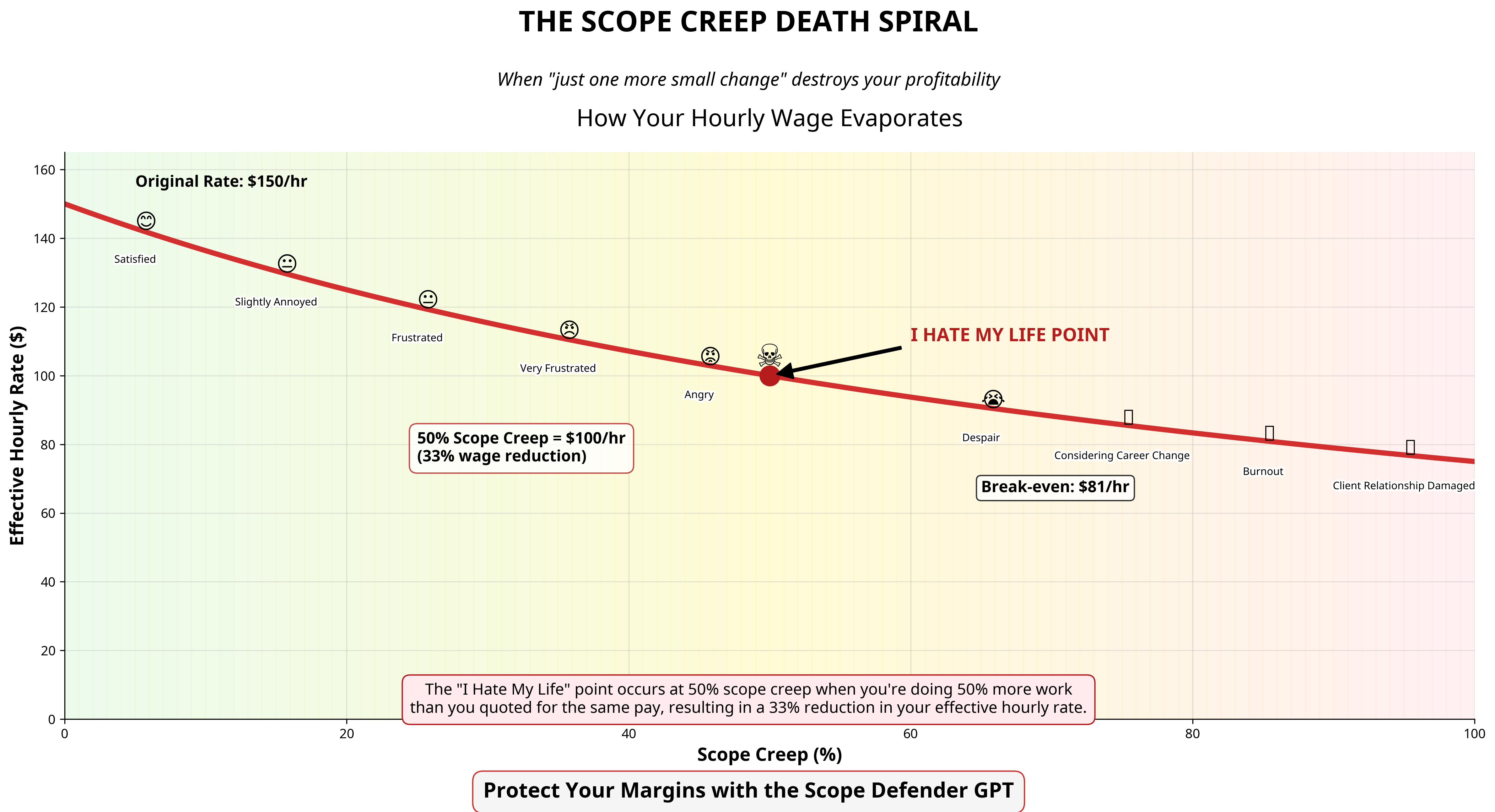“Scope creep is the agency equivalent of boiling a frog—one degree at a time until it’s too late.” – Laura Betterly
TL;DR: The Silent Profit Killer – How Scope Creep Is Bleeding Your Agency Dry
The Real Cost
- Direct profit loss: Unpaid work costs you real money
- Opportunity cost: Resources diverted from profitable work
- Team burnout: Endless revisions destroy morale and productivity
- Damaged client relationships: Saying yes to everything trains clients to devalue your work
5 Warning Signs It’s Happening
- “Just one quick thing” requests that actually consume hours of unbilled time
- Unofficial communication channels (texts, Slack) creating undocumented work
- Moving goalposts with clients who “know it when they see it”
- Too many stakeholders giving conflicting feedback
- “While you’re at it” additions that exploit your existing workflow
Root Causes You Can Fix
- Poor initial scoping and discovery
- Vague proposal documents and contracts
- The “good service” defense (fear of confrontation)
- Lack of clear change management processes
- Taking on problematic clients “for the money”
How to Stop It
- Implement a strict “no free quickies” policy with transparent billing
- Create a formalized change request system with clear approvals
- Develop detailed SOWs with specific deliverables and revision limits
- Require a single client decision-maker for feedback
- Train your team to recognize and manage scope boundaries
Turn It Into Profit
- Package common scope creep requests as upsell opportunities
- Use value-based pricing instead of hourly for scope changes
- Create tiered service packages that anticipate common additions
- Track patterns to develop new profitable service offerings
Bottom Line
Listen up, agency owners.
Scope creep isn’t just irritating—it’s a goddamn vampire sucking the life out of your profits. Yet somehow, many agency owners treat it like it’s just part of the business.
Section 1: The Real Cost of Scope Creep – Beyond the Obvious
It’s not just about the extra hours your team puts in. It’s about the systematic destruction of your agency’s profitability and sustainability.
Direct Profit Loss
Opportunity Cost
Time spent on unbilled work diverts resources from profitable projects. While your team is handling the fifteenth revision for a scope-creeping client, they could be working on that new business pitch or serving clients who respect your boundaries and pay for your expertise.
Team Burnout and Productivity Loss
Long-term Client Relationship Damage
The Compounding Effect
Case Study: The $157,000 Mistake
An agency I consulted with had a web development project scoped at $85,000 with a 12-week timeline. The client was a “big fish” they were excited to land.
But it gets worse. Because this project monopolized their development team, they had to turn down two new projects worth approximately $60,000 combined.
They also had to hire a freelancer at premium rates ($27,000) to handle other client work that couldn’t wait.
This isn’t a rare scenario. It’s happening in agencies every single day. The only question is: how much is it costing yours?

Section 2: The 5 Warning Signs Scope Creep Is Already Killing Your Profits
1. The “Just One Quick Thing” Trap
You know this one. It starts innocently enough: “Can you just quickly…” But before you know it, you’re four hours deep into unpaid work.
Let’s break down what’s really happening:
A client emails your account manager: “Can you just quickly update the headline on the homepage?” Sounds simple, right?
But here’s the actual process:
- Account manager reads email (5 minutes)
- Account manager creates task in project management system (5 minutes)
- Designer opens the file and makes the change (10 minutes)
- Designer sends for internal review (5 minutes)
- Account manager reviews and sends to client (10 minutes)
- Client requests a different font (restart process)
- Client wants to see three options (multiply time by 3)
- Client decides to go back to original (all time wasted)
What to do:
Implement a strict “no free quickies” policy. Every “small” request gets tracked and billed transparently. Create a system where these requests are batched and billed either hourly or as flat-fee “maintenance requests.”
If it’s truly quick, clients won’t mind paying. If they mind, it wasn’t quick.
2. Unofficial Communication Channels
What to do:
Direct all scope-related conversations back to a centralized system—like email, project management software, or a formalized client portal. Make it a policy that requests coming through unofficial channels must be redirected to the proper channel before work begins.
Create a client communication guide that you share during onboarding. Make it clear which channels are for what purpose, and that work requests must come through official channels to be actioned.
3. Constantly Moving Goalposts
The minute your client says, “I’ll know it when I see it,” you’re officially fucked. Undefined success criteria guarantee endless rounds of revisions and zero profit.
These projects never end; they just eventually get abandoned when either the client’s budget runs out or your team is too demoralized to continue. Either way, you’ve burned through your profit margin several times over.
What to do:
Set concrete, measurable outcomes at the start. No gray areas. Make clients sign off on these outcomes before starting. Every deliverable should have clear acceptance criteria that both parties agree to.
For creative work, use mood boards, style tiles, and reference examples to nail down subjective elements early. Get written approval on creative direction before production begins.
Implement a “revision cap” in your contracts: “This project includes up to [X] rounds of revisions. Additional revision rounds will be billed at [rate].”
4. Too Many Cooks (and Opinions)
The scenario plays out like this: You present a design to your main contact who loves it. Then the CEO weighs in with completely different feedback. Then the marketing director has their say. Then some random VP who wasn’t even in the original conversations chimes in. Suddenly you’re on version 12 with no end in sight.
Each stakeholder feels entitled to their full allotment of feedback and revisions, effectively multiplying your scope by the number of decision-makers involved.
What to do:
Insist on a single decision-maker or clearly defined process for handling conflicting feedback. Make it the client’s responsibility to consolidate internal feedback before it comes to you.
In your SOW, explicitly state: “Client will designate a single point of contact responsible for consolidating all stakeholder feedback and providing clear, actionable revision requests.”
Define the number of revisions per milestone clearly in your agreements. If they want more, great—that’s billable.
5. “While You’re At It” Requests
These little phrases (“while you’re at it…” or “could you also…?”) seem harmless. But they quickly snowball into significant unpaid labor.
What to do:
Create a formalized change-request system. Nothing gets added to the scope without a signed form outlining additional time and cost. Trust me—90% of these “just-add-this” requests vanish instantly when money is involved.
For ongoing client relationships, consider creating a “small tasks bank” where clients can purchase hours in advance for these types of requests.
Bottom line:
Scope creep isn’t inevitable; it’s predictable, manageable, and preventable. But it requires you to develop a backbone and systems to support it.
Section 3: The Root Causes of Scope Creep
Poor Initial Scoping and Discovery
Most scope creep is born before the project even begins. When you rush through discovery or skip it entirely, you’re setting yourself up for disaster.
Vague Proposal Documents and Contracts
Vague proposal documents are the number one culprit when it comes to scope creep. They lead to over-servicing your clients, which in turn leads to lower profits.
The “Good Service” Defense
This is the lie agencies tell themselves to justify giving away their services for free: “We’re just providing good client service.”
Internal Misunderstandings About Project Scope
Sometimes scope creep comes from within. If your team doesn’t have a crystal-clear understanding of what’s in and out of scope, they’ll make promises to clients that you can’t profitably keep.
- Account managers don’t fully understand the technical implications of client requests
- Creatives aren’t looped into initial scoping conversations
- Project managers don’t have visibility into resource allocation
- Team members don’t understand the financial side of the business
Lack of Clear Processes for Handling Change Requests
Even with perfect scoping and crystal-clear contracts, change happens. Clients’ needs evolve. New stakeholders enter the picture. Market conditions shift.
The problem isn’t change itself—it’s the lack of a formalized process for handling it. Without a clear change management protocol, these requests slip through the cracks and become unpaid work.
The biggest reason change orders aren’t issued is that agency leaders and employees think they don’t have enough time or it’s not worth the headache. Here’s how the thinking usually goes: “By the time I calculate the change order cost, write up a document, and get it signed by the client, I could have just made the change.”
Client Selection Issues
Let’s be brutally honest: some clients are scope creep factories. They have a track record of pushing boundaries, changing their minds, and expecting the moon for pennies.
Section 4: Bulletproof Your Agency Against Scope Creep
Implement a Strict “No Free Quickies” Policy
This isn’t just about being tough—it’s about respecting the value of your work. Every minute your team spends on a project costs you money. If you’re not billing for that time, you’re actively choosing to lose money.
Here’s how to implement this policy effectively:
-
Create a “small tasks” rate card: Develop flat-rate pricing for common small requests. For example: Text changes ($75), Simple image swap ($100), Minor layout adjustment ($150).
-
Set a minimum billing increment: Even if a task takes 10 minutes, bill for your minimum increment (typically 30 minutes or an hour).
-
Establish a request tracking system: Use your project management software to log every client request, no matter how small. This creates accountability and visibility.
-
Train your team on the policy: Role-play conversations so they’re comfortable explaining the policy to clients. Give them scripts to handle pushback.
-
Communicate the policy during onboarding: Make it clear from day one that all work, regardless of size, is billable. This sets expectations early.
Create a Formalized Change Request System
Change is inevitable in agency work. The problem isn’t change itself—it’s unmanaged, undocumented, and unbilled change.
A formal change request system creates clarity, accountability, and most importantly, compensation for additional work. Here’s how to build one:
-
Create a simple change request form: Include fields for the requested change, estimated hours, cost impact, and timeline impact.
-
Establish a clear approval process: Nothing gets added to scope without written client approval of the change request.
-
Set response timeframes: Change requests must be approved within X business days, or the project timeline is automatically extended.
-
Build change management into your contracts: Include language that explicitly outlines your change request process and makes it binding.
-
Track all change requests: Keep a running log of all approved and rejected change requests for each project. This creates a paper trail and helps with future project scoping.
Develop Clear SOWs with Specific Deliverables and Revision Limits
Your scope documents should define your deliverables, the number of revisions you’re willing to do, and each project’s timetable. Use language that leaves no room for interpretation.
Here’s what a bulletproof SOW includes:
-
Exhaustive deliverables list: Specify exactly what will be delivered, in what format, and with what specifications. If it’s not listed, it’s not included.
-
Explicit revision limits: “With this estimate, you are granted four revisions. Any revision after the fourth will result in a $250 fee per revision.”
-
Clear timeline with dependencies: Map out who needs to do what by when, including client responsibilities. Specify how missed deadlines impact the project timeline.
-
Assumptions section: Document all assumptions the project is based on. If these assumptions prove incorrect, it triggers a change request.
-
Out-of-scope section: Explicitly list what is NOT included in the project. This prevents the “I thought that was included” conversation.
Establish a Single Point of Contact Requirement
Too many cooks spoil the broth—and destroy your profit margins. Make it a non-negotiable requirement that clients designate a single point of contact who has decision-making authority.
This person is responsible for:
-
Consolidating feedback: Gathering input from all stakeholders and delivering a single, coherent set of revision requests.
-
Making final decisions: When internal stakeholders disagree, this person makes the call.
-
Approving deliverables: This person has the authority to sign off on work as complete.
-
Authorizing change requests: Only this person can approve scope changes.
Set Up Centralized Communication Systems
-
Project management software: Tools like Asana, Trello, or Monday.com can centralize tasks, feedback, and approvals.
-
Client portals: Custom portals give clients a single place to submit requests, review work, and approve changes.
-
Dedicated email addresses: Create project-specific email addresses that multiple team members can access.
Train Your Team on Scope Management
Training should include:
-
Financial literacy: Ensure everyone understands how the agency makes money and how scope creep impacts profitability.
-
Boundary-setting scripts: Give team members exact language to use when pushing back on out-of-scope requests.
-
Red flag recognition: Train them to identify early warning signs of potential scope creep.
-
Escalation protocols: Establish clear guidelines for when to escalate scope issues to management.
-
Client education techniques: Teach them how to educate clients about scope in a positive, non-confrontational way.
Implement Proper Time Tracking and Scope Monitoring Tools
You can’t manage what you don’t measure. Implement rigorous time tracking and scope monitoring to catch scope creep before it spirals out of control.
Essential tools include:
-
Time tracking software: Ensure every minute spent on client work is recorded accurately.
-
Budget tracking dashboards: Create real-time visibility into how projects are performing against budget.
-
Scope utilization reports: Track how much of the allocated scope has been used at any given point.
-
Early warning systems: Set up alerts when projects reach 75% of budgeted hours to prevent overages.
-
Client-facing reporting: Consider sharing simplified versions of these reports with clients to create transparency and accountability.
Make reviewing these metrics a regular part of your project management process. Weekly scope reviews can catch potential issues before they become profit-killing problems.
Section 5: Turning Scope Creep Into Profit Opportunities
How to Upsell Additional Services Instead of Giving Work Away
-
Package common scope creep requests: Notice patterns in what clients frequently request outside of scope? Create packaged services around these needs. For example, if clients often ask for “quick social media graphics,” create a “Social Media Support Package” you can upsell.
-
Create tiered service levels: Develop Good/Better/Best service tiers that anticipate common scope additions. When clients request something outside their current tier, it’s an easy conversation: “That’s actually included in our Premium package. Would you like to upgrade?”
-
Develop retainer add-ons: For ongoing client relationships, create specialized retainer add-ons that address common scope creep areas. “Website Maintenance Retainer,” “Content Refresh Retainer,” etc.
-
Implement the “Yes, And” technique: Instead of saying “No” to out-of-scope requests, say “Yes, and here’s how we can make that happen…” followed by a clear price and timeline.
Value-Based Pricing Strategies for Scope Changes
Value-based pricing changes the conversation entirely:
-
Focus on outcomes, not inputs: Price based on the value of the result to the client, not the hours it takes to produce.
-
Create scope change packages: Instead of billing hourly for changes, create flat-rate packages based on the value they deliver. “Brand Extension Package,” “Campaign Expansion Module,” etc.
-
Implement success fees: For certain types of work, include a base fee plus a success fee tied to measurable results. This aligns your incentives with the client’s and makes scope discussions about value rather than cost.
-
Use the “investment framing”: When discussing scope changes, frame them as investments rather than costs. “This additional $X investment will generate Y result for your business.”
Value-based pricing transforms scope conversations from contentious negotiations into collaborative discussions about how to maximize results.
Creating Tiered Service Packages That Anticipate Common Scope Additions
Prevention is better than cure. By anticipating common scope creep areas and building them into your service packages, you turn potential scope problems into profit centers:
-
Analyze your scope creep patterns: Review past projects to identify where scope typically expands. These are your opportunity areas.
-
Create strategic service tiers: Design service packages that progressively include these common additions. For example:
- Basic: 2 revision rounds, 5 pages, 1 stakeholder
- Professional: 4 revision rounds, 10 pages, 2 stakeholders
- Enterprise: 6 revision rounds, 15 pages, multiple stakeholders
-
Price tiers with healthy margins: Each tier should have progressively better margins to incentivize upselling.
-
Position higher tiers as risk reduction: “Our Professional package includes additional revision rounds to accommodate feedback from multiple stakeholders, reducing the risk of change orders.”
This approach transforms scope creep from a profit-killer into a strategic upsell opportunity.
Using Scope Creep Patterns to Develop New Service Offerings
The requests that cause scope creep today can become your profitable service offerings tomorrow:
-
Track all out-of-scope requests: Create a system to log every out-of-scope request, even ones you decline.
-
Analyze for patterns: Quarterly, review these requests to identify recurring themes and needs.
-
Develop new service offerings: Create standardized, productized services around these common requests.
-
Test with existing clients: Offer these new services to clients who have previously requested similar work.
-
Refine and scale: Based on feedback, refine these offerings and add them to your core service catalog.
For example, an agency I worked with noticed clients frequently requested help with email marketing after website launches. Instead of handling these as one-off scope creep issues, they developed a comprehensive “Post-Launch Email Marketing Package” that became one of their most profitable offerings.
Client Education Strategies That Protect Profits
Educated clients are better clients. By proactively educating clients about how agencies work, you can prevent scope creep before it starts:
-
Create a client onboarding process: Develop materials that clearly explain your process, boundaries, and how changes are handled.
-
Host “How We Work” sessions: At project kickoff, walk clients through exactly how your process works, including how scope changes are handled.
-
Provide scope management guides: Give clients documentation on how to effectively manage their end of the project to prevent scope issues.
-
Share case studies: Show examples of successful projects that stayed within scope and the results they achieved.
-
Offer scope management workshops: For larger clients, consider offering workshops on how to effectively manage creative projects.
The goal isn’t to train clients to be agency experts, but to give them enough understanding to be good partners in the process.
Maintaining Integrity in Client Selection
There is no shortage of people who genuinely need and deserve an agency’s help. Why waste your limited resources on clients who don’t respect your time and expertise?
Implement these client selection strategies:
-
Create a client qualification process: Develop criteria for identifying ideal clients who respect boundaries and value your expertise.
-
Implement red flag detection: Train your sales team to spot warning signs of scope creep-prone clients during the sales process.
-
Conduct regular client profitability reviews: Analyze which clients are actually profitable after accounting for scope creep and over-servicing.
-
Develop a client graduation program: Create a system for transitioning problematic clients to other solutions that better fit their needs and budget.
-
Raise rates strategically: For clients who consistently push boundaries, implement strategic rate increases that either improve profitability or encourage them to move on.
Remember: Every hour you spend over-servicing a bad client is an hour you could spend finding and delighting a good one.
Conclusion: Take Back Control of Your Agency’s Profitability
Throughout this guide, we’ve uncovered the true cost of scope creep, identified the warning signs it’s already happening in your agency, explored the root causes, and armed you with bulletproof strategies to not only prevent it but transform it into profit opportunities.
Here’s what we know for sure:
Nearly 40% of agencies exceed their budgets because of scope creep. That’s not just a statistic—it’s a wake-up call. Every time you say “yes” to that “quick change” or “small addition,” you’re actively choosing to reduce your profitability.
But the agencies that thrive aren’t the ones who never face scope creep—they’re the ones who’ve developed systems to manage it effectively. They’re the ones who’ve trained their teams to have difficult conversations. They’re the ones who respect themselves enough to enforce their boundaries.
The strategies in this guide aren’t theoretical—they’re battle-tested approaches that have saved agencies hundreds of thousands of dollars in lost revenue:
- Implementing a strict “no free quickies” policy
- Creating a formalized change request system
- Developing clear SOWs with specific deliverables and revision limits
- Establishing a single point of contact requirement
- Setting up centralized communication systems
- Training your team on scope management
- Implementing proper time tracking and scope monitoring tools
- Turning scope creep patterns into profitable service offerings
- Maintaining integrity in client selection
The question isn’t whether these strategies work—it’s whether you have the courage to implement them.
Because let’s be honest: saying “no” is hard. Having difficult conversations about money is uncomfortable. Setting boundaries with clients feels risky.
But you know what’s harder? Working 70-hour weeks for diminishing returns. What’s more uncomfortable? Realizing you can’t make payroll
because your projects aren’t profitable. What’s riskier? Watching your agency slowly bleed to death from a thousand scope creep cuts.
So here’s my challenge to you: Pick one strategy from this guide and implement it this week. Not next quarter, not when things slow down, not after you finish your current projects. This week.
Start small if you need to. Create that change request form. Draft those email templates for your team. Set up that time tracking system. Just start somewhere.
Because scope creep isn’t inevitable; it’s predictable, manageable, and preventable. It’s your business—protect your boundaries, defend your margins, and stop apologizing for running your agency like the profitable enterprise it deserves to be.
The choice is yours: Keep running the hamster wheel, or get shit done differently.
I’ve shown you how. But only you can make it happen.
Time to decide.



